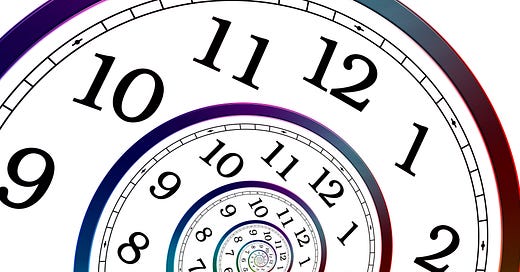Field Notes (16): Temporal Layers and Virtual Zeitgebers
The Impact of Object Motion on Temporal Experience
Landeck et al. (2024) argue that time perception, a fundamental aspect of human cognition, is influenced by environmental cues known as zeitgebers. Their recent article explores the impact of manipulating time perception in Virtual Reality (VR) by altering the speed and pattern of motion in objects associated with timekeeping. This exploration can be juxtaposed with Reinhart Koselleck’s conception of historical time, which introduces key concepts such as the “space of experience” (the repository of past experiences shaping present perspectives) and the “horizon of expectation” (the projection of possibilities and anticipations into the future). Together, these perspectives offer a nuanced understanding of how modern manipulations of perceived time in VR could influence our engagement with historical temporality.
Koselleck’s (2004) differentiation between the “space of experience” and the “horizon of expectation” provides a robust theoretical framework for analyzing the influence of virtual zeitgebers on historical time perception. The central thesis of Landeck et al.’s study is that the speed and irregularity of motion in virtual objects significantly influence how time is perceived by users in VR environments. The researchers hypothesize that accelerating the internal motion of virtual timekeeping objects, such as clocks and pendulums, can make time seem to pass more quickly. The irregular motion of these objects, which demands higher attention, is expected to amplify this effect. While this study provides valuable insights into how virtual zeitgebers alter users’ temporal experiences, reshaping their historical consciousness, the findings should be understood as contextually limited to VR environments and require further empirical testing to generalize these effects.
Virtual Zeitgebers and Historical Temporality
Landeck et al. delve into the concept of zeitgebers, both traditional (like clocks) and virtual, and their impact on time perception. The study emphasizes that the internal motion speed of these virtual zeitgebers can manipulate users’ temporal experiences in VR. For example, an orbit pendulum with irregular motion was found to significantly accelerate the perceived passage of time compared to a clock with regular motion. These findings, while promising for enhancing engagement and immersion in VR, are specific to controlled virtual environments. Koselleck’s framework allows us to understand these manipulations as influences on the “horizon of expectation,” reshaping how individuals engage with and comprehend historical events and durations within virtual contexts. However, whether these effects carry over to non-virtual environments or broader historical understandings remains speculative and requires further exploration.
Sattelzeit and Technological Transformations
Koselleck’s concept of Sattelzeit, which marks the transition to modern temporal understanding, parallels the transformative potential of VR on contemporary time perception. Although it is tempting to draw a direct equivalence between VR’s ability to manipulate perceived time and a modern Sattelzeit, this comparison should be viewed as a theoretical analogy rather than a definitive transformation. The ability of VR to alter perceived time may contribute to evolving temporal experiences, but its impact on historical understanding must be critically assessed, particularly regarding its applicability beyond digital contexts. The integration of faster and irregular motion patterns into virtual objects can certainly enhance engagement and reduce boredom, yet such applications might reflect an extension of existing practices rather than a fundamental redefinition of temporal experience.
Concluding Thoughts
Integrating Koselleck’s theoretical insights with the empirical findings of Landeck et al. provides a compelling perspective on the intersection of historical time and contemporary time perception technologies. However, the practical implications of this intersection remain underdeveloped. For instance, how might these findings inform the design of VR-based historical education tools or virtual museums? By incorporating irregular motion patterns in timekeeping objects, VR environments could potentially enhance user engagement and improve retention of historical knowledge. Moreover, further interdisciplinary studies are needed to test the generalizability of Landeck et al.’s findings and to critically examine the broader implications of virtual zeitgebers on historical consciousness. Understanding both the limitations and possibilities of these technologies is essential for advancing historiography and cognitive engagement in the digital age.
References
Koselleck, R. (2004). Futures Past: On the Semantics of Historical Time. Columbia University Press.
Landeck, M., Unruh, F., Lugrin, J.-L., & Latoschik, M. E. (2024). Object motion manipulation and time perception in virtual reality. Frontiers in Virtual Reality, 5, 1390703. https://doi.org/10.3389/frvir.2024.1390703



